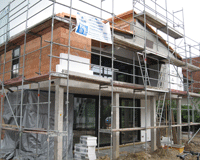 Are you sitting on a few of the 5,000 acres of brownfield land the government plans to have councils zone for the construction of 200,000 starter homes by 2020? That’s 50,000 a year from next April, to get with the programme.
Are you sitting on a few of the 5,000 acres of brownfield land the government plans to have councils zone for the construction of 200,000 starter homes by 2020? That’s 50,000 a year from next April, to get with the programme.
Don’t get over-excited, but it’s possible that the land beneath your shed park could become worth £1.2m an acre instead of £500,000. But don’t count your change-of use bonus just yet. As Eisenhower said: “Plans are nothing: planning is everything.”
A Machiavellian member of the Office of Parliamentary Counsel needs to be carefully planning the words in the Housing Bill, due to be tabled this autumn. Otherwise, the manifesto promise to complete these starter homes by 2020 will become a rod for Labour to beat the Conservatives and a stick to bang the council house drum, especially if Jeremy Corbyn is leader.
Right now, the pledge has more holes to wiggle through than a wedge of Emmental.
This is the plan: all units are to be reserved for first-time buyers aged under 40. The starter homes will be sold at 20% below open market prices – a discount made possible by building on land zoned for this purpose. Land will supposedly be made cheaper by councils forgoing section 106 payments. Councils have been told to identify all brownfield sites in their area, and to grant builders planning permission on 90% of these sites by 2020.
The idea that 50,000 starter units will spring up each year from April 2016 is derisory.
A one-third surge on current volumes is not going to happen. Watch for lots of wiggle room in the bill.
Next, what does “quality starter homes” mean? A slate front step and brass knocker? It should, of course, mean minimum unit sizes and maximum densities.
If the bill does not contain these measures, then “quality” will mean naught.
Easy to define who is under 40 and a first-time buyer. Hard to stick with a sales price “20% below market”. Actually, near impossible. New homes are routinely sold at 20% above the market price of secondhand homes. Fixing the price of starter homes to the price of new homes simply makes them as expensive as pre-owned homes. The whole exercise will become a valuer’s nightmare and a manipulative seller’s dream.
Councils “must identify all brownfield sites”, says the manifesto. Really? Councils were ordered to produce structure plans three years ago. Half of them are yet to bother.
What can possibly persuade them to red-line scruffy industrial estates and scrubland? Do they really want monocultural developments for the poor, fated to become the private slums of tomorrow?
The idea that builders will clamour for the land and that 90% of it will have permission by 2020 is risible.
We have a Conservative government and a sensible secretary of state for communities and housing in Greg Clark. This is an administration that should surely understand the limits of the state and be able to identify the point at which the free market must take over.
Here is what can be done. Identify and zone land. Drop the unworkable discount – it’s a fiddler’s charter. Don’t drop the section 106 requirements – councils rely on the money. Demand minimum sizes and maximum densities, which will help to prevent slums. Drop the socially exclusive idea of 100% starter homes. Stiffen the current mix of 70% private, 30% affordable by ensuring the latter are built on-site.
After that, stop worrying and blame the builders.
• Landowners need not worry if this starter home plan fails in the planning. A fine firm of agents has done the maths.
The residual land values for a one-acre site in the South East containing 15,000 sq ft of discounted starter homes is £1,253,396. That number is based on £280 per sq ft and zero section 106 contribution.
The residual land value for building 70% private homes at £350 per sq ft and 30% affordable homes at £110 per sq ft and a £5,000 per unit section 106 contribution? Exactly £1,182,804.
In other words, cheer on the government in its re-zoning efforts – but don’t fret if the discounted starter home plan unravels.











